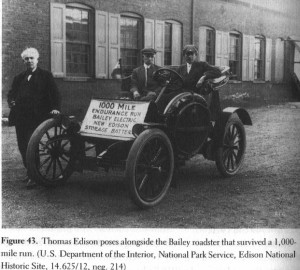Wednesday 18 June 2014
I just finished reading “Edison Inventing the Century” by Neil Baldwin, an excellent biography of one of the most prolific inventors and entrepreneurs ever – one who still shapes our lives today. Edison’s most important innovation was not the light bulb, the phonograph (the one he was proudest of), the electric voting machine, the moving picture camera, the iron ore separator, the electricity meter, or the electrical distribution system, but the “invention of invention” – meaning the invention of systematic research and development to find solutions to technical problems and then improve upon them.
I have written before of the hype cycle in innovation and there is no doubt that Edison was also a master of hype – often announcing inventions were ready well before they actually were. He did, however, end up with 1,093 US patents (2,332 world-wide) – a number not surpassed by anyone until 2003 – making him one of the most prolific inventors ever. Another interesting part of the book covers Edison’s development of batteries for electric cars – a story with lots of resonance today.

Already by 1896 people were worrying about pollution from gasoline engine cars. Pedro Salom, a chemist, wrote in the Journal of the Franklin Institute; “all the gasoline motors which we have seen, belch forth from their exhaust pipe a continuous stream of partially unconsumed hydrocarbons in the form of a thick smoke with a highly noxious odour”. Obviously the control of combustion and fuel quality was not what it is today – and as well as pollution people worried about frightening the horses. Salom was not without a vested interest here as he co-founded the Electric Carriage and Wagon Company Inc. at the start of 1896. By 1900 Edison had decided electric cars were the way forward – they were outselling steam cars and gasoline cars at the time – and wanted to replace the heavy lead acid battery. He spent three years testing different alkaline batteries looking for longer life, durability, safety and a much better weight to energy ratio – all those parameters we continue to seek in battery technology today. He settled on using a positive pole of iron and a negative pole of superoxide of nickel with an aqueous solution of potassium hydroxide as an electrolyte – what we call a nickel-iron battery. He crash tested them by having them thrown from a third floor balcony – a great image.
In May 1901 Harper’s Magazine said: “the famous inventor considers his new storage battery the most valuable of all his inventions, and believes it will revolutionise the whole system of transportation“. He built an assembly plant which opened in May 1901 to produce “500 cells daily” with a target cost of $10 and sales price of $15. The plant produced different designs optimised for different vehicles including cars and delivery wagons plus illuminating train carriages. Edison’s fame and ability to get publicity led to a good start with strong sales for a year or so before technical issues were discovered. Cells leaked and power losses of 30 per cent occurred under repeated charging and discharging. Edison continued to innovate – adding nickel flake within the positive plate increased watt hour capacity per pound by 40 per cent – but in the end the market rejected electric vehicles as the gasoline engine improved and the problems with batteries were recognised. The business – The Edison Storage Battery Company – carried on making batteries for other applications and was sold to Exide in 1972 who then stopped making nickel-iron batteries in 1975.
Interestingly a 2012 Nature Communications article reported that Stanford University researchers had applied nano-technology to the nickel-iron battery with promising lab results – so perh
aps Edison’s technology will make a comeback.
Edison’s friend and collaborator on electric cars, Henry Ford once famously said “history is more or less bunk” but history can be helpful for understanding the present. “Edison Inventing the Century” has plenty of insight into the development of the modern electricity system as well as the (timeless?) issues around innovation.
Comments
Comments are closed.
Dr Steven Fawkes
Welcome to my blog on energy efficiency and energy efficiency financing. The first question people ask is why my blog is called 'only eleven percent' - the answer is here. I look forward to engaging with you!
Tag cloud
Black & Veatch Building technologies Caludie Haignere China Climate co-benefits David Cameron E.On EDF EDF Pulse awards Emissions Energy Energy Bill Energy Efficiency Energy Efficiency Mission energy security Environment Europe FERC Finance Fusion Government Henri Proglio innovation Innovation Gateway investment in energy Investor Confidence Project Investors Jevons paradox M&V Management net zero new technology NorthWestern Energy Stakeholders Nuclear Prime Minister RBS renewables Research survey Technology uk energy policy US USA Wind farmsMy latest entries
- Gee, I wish we could have a white Christmas, just like the old days….
- A look back at the last forty years of the energy transition and a look forward to the next forty years
- Domains of Power
- Ethical AI: or ‘Open the Pod Bay Doors HAL’
- ‘This is not the end. It is not even the beginning of the end. But it is, perhaps, the end of the beginning’
- You ain’t seen nothing yet
- Are energy engineers fighting the last war?


